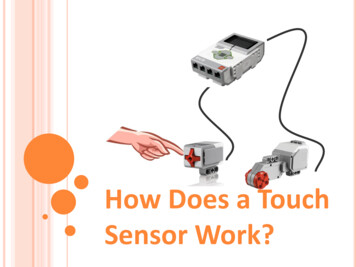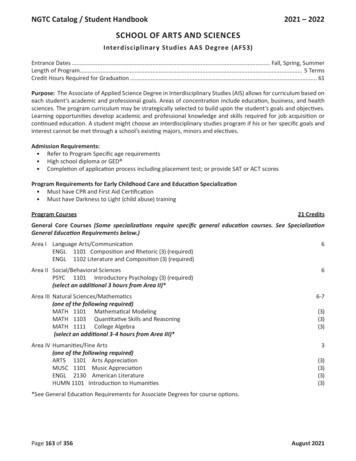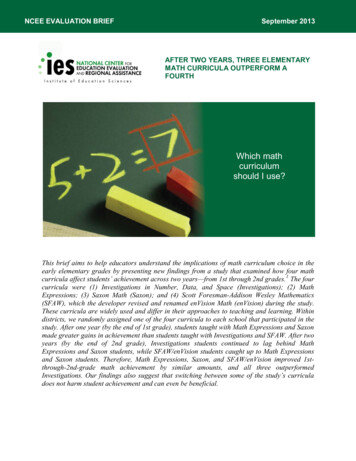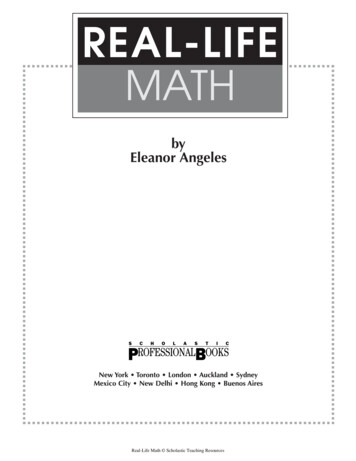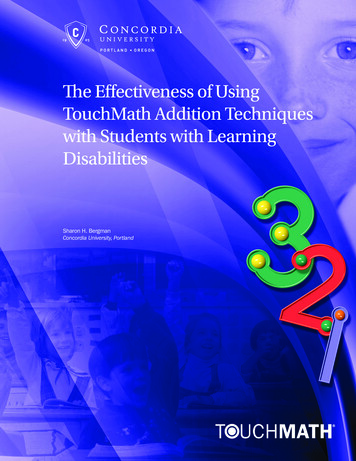
Transcription
The Effectiveness of UsingTouchMath Addition Techniqueswith Students with LearningDisabilitiesSharon H. BergmanConcordia University, Portland
1Running head: TOUCHMATH ADDITION TECHNIQUESThe Effectiveness of Using TouchMath Addition Techniques with Students with LearningDisabilitiesSharon H. BergmanConcordia University PortlandAn Action Research Report Presented toThe Graduate Program in Partial Fulfillment of the RequirementsFor the Degree of Masters in EducationConcordia University-Portland2014
TOUCHMATH ADDITION TECHNIQUES2The Effectiveness of Using TouchMath Addition Techniques with Students with LearningDisabilitiesThis literature review was completed to determine the research that has been done on theusefulness of TouchMath as a strategy for solving addition problems for students who haveIndividual Education Plans (IEP’s). According to the National Center for Learning Disabilities(NCLB), students with special needs often have problems with memory and therefore find itdifficult to remember math facts and keep a sequence of steps in order. These students aresometimes referred to as having dyscalculia. They require specialized instruction and alternate ormodified content in order to be successful in the general education classroom. Acquisition ofmath facts needs to be approached in different ways. When basic math facts are not masteredearly on, students who have dyscalculia may have difficulty understanding more advanced mathapplications.With the introduction of the Common Core State Standards (CCSS), it is now moreimportant than ever that students acquire the ability to perform math calculations. “TheCommon Core defines the knowledge and skills that students from pre-kindergarten to 12th gradeneed to master each year to be prepared for the next grade and ultimately college or work”(inside schools.org, 2014). With that in mind, this research paper seeks to answer the question:Will students with IEP’s who are taught TouchMath addition strategies in the resource roomperform better on assessments using TouchMath as opposed to using the traditional additiontechniques taught in the general education classroom? The hypothesis is that the students willhave higher scores on math assessments when they use the TouchMath technique for solvingaddition problems.
TOUCHMATH ADDITION TECHNIQUES3Review of LiteratureAn elementary school teacher named Janet Bullock developed the TouchMath Programin 1975. She was concerned because many of her students were having difficulty with mathconcepts (TouchMath.com, 2014). She decided that a new method needed to be taught so thather student’s skills, math facts and confidence in mathematics could improve. Her method wasto place counting points on numbers in order to teach that a symbol represents a quantity. Herstudents had a lot of success with the method and she discovered a way of transitioning themfrom concrete to symbolic learning. In the TouchMath system, each numeral from one to ninehas dots on it. These dots are visual reminders for students to count in order to accurately solve amath problem. Part of the program involves memorizing the location and amount of the touchpoints on each number, remembering the multiples of numbers (for multiplication) and countingbackwards (for subtraction). The goal of the program is for the student to eventually internalizethe points so that they are no longer needed in order to solve math problems.The program is based on a report released by Kramer and Krug (1973). In this methodof solving mathematical problems, dots were placed on numerals in a pattern modeled off of diceand dominoes. Kramer and Krug (1973) felt the TouchMath system might be helpful forteaching computation to children with special needs. Scott (1993) continued the research andconducted a study to examine using a multisensory program to instruct students with milddisabilities in addition and subtraction concepts. TouchMath was chosen for the study because itwas not based on memorization of facts but was a technique for acquiring the facts (Scott, 1993).Scott taught three elementary students with mild disabilities how to do double digit addition withregrouping and double and triple subtraction with regrouping. Her results were that the students
TOUCHMATH ADDITION TECHNIQUESmade significant progress in the targeted skill. The students were able to maintain theirknowledge and were able to generalize their knowledge to other mathematical situations. Shegeneralized that the results showed that TouchMath was a useful method for special educationstudents as well as general education students because the students in the general educationclassroom also showed interest in learning the technique.In 2001 a study was conducted which focused on using creative memorization strategiesto improve math achievement (Bielsker, Napoli, Sandino & Waishwell, 2001).First and second graders were chosen because they were having difficulty memorizing mathfacts. Three interventions were used; TouchMath, multiple intelligences and mnemonics toincrease the amount and quality of retention. The study indicated that students increased theirability to remember math facts and decreased their need to use manipulatives in order to solvemath equations. TouchMath was successful for the lower achieving students but the higherachieving students did not need the dot strategy to help them remember math facts (Bielsker, etal., 2001).In 2002, Wisniewski and Smith conducted a study with four third and fourth gradestudents with intellectual disabilities, students with learning disabilities and students with otherhealth impairments. The students received TouchMath instruction for 20 minutes a day forfourteen weeks in the resource room. They were tested weekly on math Mad Minute additiontests. Based on a pre and posttest, all of the students improved their accuracy and speed ofsolving addition facts. In another study, eleven first graders who were at-risk for academicdifficulties were given TouchMath instruction as an intervention. They were also giveninstruction in reading using the Orton Gillingham program, a multi-sensory approach to readinginstruction (Orton, 1966; Sheffield, 1991). All eleven of the students were at the pre-first grade4
TOUCHMATH ADDITION TECHNIQUES5level for reading and spelling. Seven of the students were at a pre-first grade level inmathematics and the other four were at the early first grade level. They were instructed inreading phonics for 25-55 minutes a day and also in TouchMath for 25-55 minutes a day whilethey attended first grade. They continued to use both methods for instruction in the secondgrade. However, they did not require reteaching of TouchMath because none of the studentsneeded the additional instruction in order to accurately use it. After two years of theintervention, the students were no longer considered at risk for special education services (Dev,Doyle, & Valente, 2002).Students with Learning Disabilities in math were taught three row double-digit additionproblems using TouchMath (Hanrahan & Simon, 2004). Before the intervention the studentswere solving math problems using a count-all and count on strategy. In a count all strategystudents rely on touching and counting every object in order to accurately solve a simple additionor subtraction problem. In a count on strategy, students start from the highest number and counton the amount that needs to be added. These students also heavily relied on using their fingersfor counting. The results were that some of the students were able to learn the TouchMathstrategy, apply it and remember it for up to four months after they were instructed in the method.Elementary students with Autism were taught single-digit addition problem solving skillsusing a number line and TouchPoint strategies (Cihak & Foust, 2008). Prior to the study thestudents could not correctly calculate single-digit addition problems. The results were that thetouch-point strategy was more effective. This study was extended to three middle school studentswith Autism and moderate intellectual disabilities. They were taught how to solve single-digitmathematics problems using a number line (Boon, Cihak, & Fletcher, 2010). The results
TOUCHMATH ADDITION TECHNIQUES6indicated that the TouchMath strategy was more effective and efficient in teaching studentssingle digit addition problems.In 2008, a study by Mays included two classes of second grade students. Of the fortystudents, nine of them had IEP’s. The two classes were instructed for six weeks in TouchMathaddition strategy instead of their regular math curriculum. As a pretest the students were giventwenty single digit addition math problems and timed for one minute to see how many problemsthey could solve. Then they were instructed in the TouchMath strategy for several weeks andgiven daily practice. The results were that the use of Touch Math increased computation skillsand promoted a strategy that the students could use independently. Seventeen of the thirty-fourstudents showed 100% improvement in their scores. The students showed increased motivationfor math and they felt the addition strategy was an easier method for them than the traditionaladdition method (Mays, 2008).“Three second graders with mild intellectual disabilities who were in an inclusiveclassroom were instructed in addition skills using TouchMath in order to investigate theeffectiveness, generalizability and the permanency of the instruction” (Calik & Kargin, 2010).The results showed that TouchMath instruction based on direct instruction is effective inteaching basic addition skills. The study also demonstrated that all the teachers had positivefeelings toward the program and they stated that they would use the program in their classroom.The effects of teaching high schoolers with mild intellectual disabilities money problemsthat involved three digits with regrouping was studied (Boon & Water, 2011). The studentsreceived instruction in a self-contained classroom. The results showed that the TouchMathprogram improved all three of the student’s ability to subtract three digit numbers involvingmoney. However, once the intervention was discontinued, some of the students had difficulty
TOUCHMATH ADDITION TECHNIQUES7maintaining the skills. Three students with Physical Disabilities (Spina Bifida, Cerebral Palsyand Stroke) were instructed using TouchMath in basic computational skills of problems withsums up to 20. All students were successful in the skill and were able to generalize and maintainthe strategies they were taught (Avant, Thompson, & Wolff, 201l).The ability to add quicker and more accurately was studied in 2013 by Ullrich. A thirdgrade classroom of twenty-four students was instructed in TouchMath for eight weeks, thirtyminutes a day, for four days a week. Half of the students had scored below the fiftieth percentilein the Measure of Academic Progress Test. These students were administered pretests, posttests,daily and weekly testing and timed tests to track their progress using TouchMath. The resultswere that TouchMath increased their math fluency regardless of gender, first language spoken orschool attendance. They also increased their positive attitude towards math and they felt that theuse of the TouchPoints was the key strategy that increased their scores (Ullrich, 2013). Theauthor recommended “Mathematics instruction incorporating the TouchMath program beimplemented in lower elementary classes because using the TouchPoints on numerals bridges thegap between concrete experiences and abstract concepts” (Ullrich, 2013).AnalysisThe literature review has examined the research of the effectiveness of using TouchMathstrategies with students with disabilities. The review of these works has improved thisresearchers understanding of the positive impact that TouchMath can have on the success ofstudents who have difficulty with math because of their disabilities. The review of these studieshas enlightened the researcher on the topic and will help in designing the research.The analysis of the literature showed that using TouchMath can be an effective tool forstudents with disabilities whether they are elementary students with mild disabilities (Scott,
TOUCHMATH ADDITION TECHNIQUES81993), kindergarten students with memory issues (Bielsker, et al, 2001), third and fourth graderswith intellectual disabilities, learning disabilities or other health impairments (Wisniewski &Smith, 2002), (Calik & Kargin, 2010), high school students with mild intellectual disabilities(Boon & Water, 2011), first graders at risk for learning disabilities (Dev, Doyle & Valente,2002), elementary students with Autism (Cihak and Foust, 2008), middle school students withAutism (Boon, Cihak, & Fletcher, 2010) and twenty four third grade students in which half ofthe students were below the fiftieth percentile in the Measures of Academic Progress Test(Ullrich, 2013). All the studies shared the same theme that students with all types of disabilitieswho have difficulty remembering math facts have more success with the TouchMath strategythan they do with traditional methods of solving addition problems. It was even noted that thosestudents with no learning disabilities had success using TouchMath.ConclusionBased on the success of the research studies that have been previously conducted usingTouchMath, it is concluded that this researchers study will have similar positive results. Themere fact that TouchMath is a multi-sensory technique for solving math problems makes it anexcellent tool to be used with students with learning disabilities. Often these students need tostimulate their senses and they have a particular sense that is strength for them. TouchMathmakes use of the sense of touch and is called a tactile method. By implementing the multisensory strategy of TouchMath in the resource room with students who have IEP’s, it ishypothesized that they will perform better on assessments using that tool as opposed to using thetraditional addition techniques that are taught in the general education classroom.
TOUCHMATH ADDITION TECHNIQUES9ReferencesAvant, M. T., & Heller, K. W. (2011). Examining the effectiveness of TouchMath with studentswith physical disabilities, Remedial and Special Education, [Abstract]. Remedial & SpecialEducation, 32(4), 309.Bielsker, S., Napoli, L., Sandino, M., & Waishwell, L. (2001). ERIC - Effects of direct teachingusing creative memorization strategies to improve math achievement. Retrieved fromhttp://eric.ed.gov/?id ED460855.Boon, R. T., Cihak, D. F., & Fletcher, D. (2010). Effects of the TouchMath program compared toa number line strategy to teach addition facts to middle school students with moderateintellectual disabilities. Division on Autism and Developmental Disabilities Effects of theTOUCHMATH Program Compared to a, 45, 449-458.Calik, N. C., & Kargin, T. ERIC - Effectiveness of the TouchMath technique in teachingaddition skills to students with intellectual disabilities, International Journal of SpecialEducation, 2010. Retrieved from http://eric.ed.gov/?id EJ890578.Dev, P. C., Doyle, B. A., & Valente, B. (n.d.). Labels needn't stick: "at risk" first gradersrescued with appropriate intervention (Unpublished master's thesis). Nazareth College ofRochester, Rochester, New York.Hanrahan, J. & Simon, R. An evaluation of the TouchMath method for teaching addition tostudents with learning disabilities in mathematics, European Journal of Special NeedsEducation, 2004-June. Retrieved from http://eric.ed.gov/?id EJ681567.Hanrahan, J., An analysis of an imprinted-dot approach to teaching arithmetic to intellectuallydisabled children and its potential for facilitating inclusion - ISEC 2000. Retrieved from
TOUCHMATH ADDITION acts/papers h/hanrahan 1.htm.Mays, D. (2008). TouchMath: An intervention that works (Unpublished master's thesis). AsburyCollege, Wilmore, Kentucky.Multisensory Teaching Ideas and Materials for LD Students. (n.d.). Retrieved uctionalmaterials/p/mulitsensory.htm.Scott, K. S. (1993), Multisensory mathematics for children with mild disabilities.Exceptionality: A Research Journal. Retrieved from http://eric.ed.gov/?id EJ468855.Sheffield, B. B. (1991). The structured flexibility of Orton-Gillingham. Annals of Dyslexia,41, 41-54.Smith, D., & Wisniewski, Z. G. (2002). ERIC - How effective Is TouchMath for improvingstudents with special needs academic achievement on math addition mad minute timed tests?Retrieved from http://eric.ed.gov/?id ED469445.Strand, L., (n.d.). The TouchMath program and its effect on the performance of first graders(Unpublished master's thesis). Bowling Green State University, Bowling Green, Ohio.TouchMath, the Leading Multisensory Teaching Approach that Bridges Manipulation &Memorization. (n.d.). Retrieved fromhttp://www.touchmath.com/index.cfm?fuseaction about.story.Ullrich, C. (2013). The effects of mathematics instruction incorporating the TouchMath Programon addition computational fluency in a third grade classroom (Unpublished doctoraldissertation). University of Arkansas, Fayetteville, Arkansas.What Is Dyscalculia? Mathematics Disability. (n.d.). Retrieved from ulia/what-is-dyscalculia.
TOUCHMATH ADDITION TECHNIQUES11What is the Common Core? (n.d.). Retrieved from 80%99s-the-common-core.
TOUCHMATH ADDITION TECHNIQUES12CAPSTONE PROJECT DOCUMENTATION FORMAction Research is an exciting, disciplined process of discovery designed tointegrate theory into one’s daily practice in a way that improves educationalpractices and the individual conducting the research. Action Research is theCapstone Project in the Master’s of Education program for ConcordiaUniversity online. It gives the educator, as a scholarly practitioner, theopportunity to examine relevant issues in his or her own classroom or schoolwhich may complicate, compromise, or complement the learning process—and to find meaningful, practical, research-based answers.In Action Research, teachers are empowered to design a research-basedplan, identify learning issues or problems, review relevant literature thatexamines identified problems, implement specific, research-based strategies,and discover convincing evidence that supports or contravenes theirteaching strategies. The most exciting part of Action Research is the teachercan often observe student improvement during the project and candemonstrate, in a quantitative manner, the improvement of studentlearning. Sagor notes, “Seeing students grow is probably the greatest joyeducators can experience” (2002, p. 5).The steps to the Capstone Project are detailed below. Read through all ofthe steps before creating your implementation plan. Save this form as adraft until all Action Research steps have been completed and allresponses are documented. You will submit this form at differentstages of completion throughout EDU 698.ACTION RESEARCH PROJECTName: Sharon BergmanTitle of Project: The Effectiveness of Using TouchMath Addition Techniqueswith Students with Learning DisabilitiesDate Completed: 10/03/14IMPLEMENTATION TIME FRAME:Number of weeks: 2TIMELINE of ACTION RESEARCH PROJECT:Start Date: 9/15/14
TOUCHMATH ADDITION TECHNIQUES13End Date: 9/26/14AREA OF FOCUS: What is your chosen area of focus? Why did you choose this area? How does it directlyimpact you?The main goal of this action research plan is to determine if students with learningdisabilities who have IEP’s perform addition problems more accurately using TouchMath as opposed to the traditional method for solving addition problems. The chosenarea of focus is math and specifically TouchMath because it is used on a daily basis withspecial education students who have math goals and they seem to excel when using it.The intent of the research is to compare the student’s scores on an assessment using thetraditional method of addition as opposed to using TouchMath. When the specialeducation students use TouchMath they genuinely seem excited because for the first timethey feel successful with the ability to solve problems correctly that they previously werenot able to solve. Since it is a new year and there are new students who are unfamiliarwith TouchMath, this researcher wants to look at their experience with using TouchMathand see if they are able to achieve the same positive results that previous students hadachieved. The topic is narrow enough to collect data and see improvement in the timeframe allotted. The research will begin with a pre-assessment using traditional math onDay l, followed by instruction using TouchMath on Day 2 & 3, and practice on days 4, 5,6, 7, 8 and 9. On Day 10 a post-assessment will be conducted. This should be anadequate amount of time to achieve valid results.RESEARCH QUESTION:
TOUCHMATH ADDITION TECHNIQUES14Will students with IEP’s who are taught TouchMath addition strategies in the resource room perform betteron assessments using TouchMath as opposed to using the traditional addition techniques taught in thegeneral education classroom?DEMOGRAPHICSDEMOGRAPHIC DATA: Where/What is the research site? Who is directly involved? What statistics willgive a clear understanding of the context and culture of the research site? (Do not use name as anidentifier.) Provide references for sources used.This will be an action research plan that is quantitative in nature in order to answer thequestion: Will students with IEP’s who are taught TouchMath addition strategies in theresource room perform better on assessments using TouchMath as opposed to using thetraditional addition techniques taught in the general education classroom? The researchwill also aim to answer the question: Will students with learning disabilities feel betterabout math if they have an alternative method for solving addition problems?The demographic data is elementary school children from the Stamford Public Schools inStamford, Connecticut. These students will be from an ethically and culturally diverseschool representing over forty languages and countries of origin. The school has a largebilingual program for Spanish speaking students and it is the home of the district’selementary Hearing Impaired Program. The Stamford Public Schools is a large urbanTitle One public school system. The district comprises 16,000 students, 1,500professionals and 20 schools, including six magnet and two International Baccalaureateschools. Stamford Public Schools has a total of twelve elementary schools, five middleschools, a pre-school center and three high schools.
TOUCHMATH ADDITION TECHNIQUES15TARGET GROUP: Who are the students you are trying to impact? (Do not use names - you must useanother identifier.) How do you think this strategy or content focus will benefit the target group?The students in the target group are students with disabilities who get their math supportin the resource room but receive their regular math instruction in the general educationclassroom. The group is comprised of four third grade students who have IndividualEducation Plans for math and reading. They specifically have goals and objectives listedon their IEP for solving of addition problems with regrouping. The students are 8-9 yearsold. Three of the students are girls and one of the students is a boy. The boy (Student A)is Black and identified as a Student with Attention Deficit/Hyperactivity Disorder and islabeled as OHI (Other Health Impaired). One girl is Black (Student B) and identified as astudent with learning disabilities. Another girl is Hispanic (Student C) and is identifiedas a student with learning disabilities. The other girl is white (Student D) and isidentified as a student with Autism Spectrum Disorder. The benefit to these students withthis research will be to offer an alternative method for them to solve addition problemswith regrouping so they can be more successful on their assessments and feel better abouttheir math ability.BASELINE DATA: What are the baseline data that support your choice for this area of focus? Whatpatterns or trends do you see in the data? What is your proof that an issue exists in this focus area?(NOTE: You may not depend solely on Standardized Test Scores.)The baseline data is the scores that students with disabilities who have math goals andobjectives on their IEP’s receive when using traditional methods for solving additionproblems. Students with disabilities often have difficulties with memory and cannot
TOUCHMATH ADDITION TECHNIQUES16remember math facts. When adding numbers together, they rely on their fingers or othermanipulatives to help them solve the problems. TouchMath is another method forsolving math problems without having to memorize facts. The students need to knowhow to count and how to count up from a number in order to be successful. The baselinedata will be assessed by administering a pre-test using traditional addition techniques.Baseline data will also be established by using a pre-survey to see if student’s attitudetowards math changes after they have success using TouchMath.ACTION PLANIMPLEMENTATION PLAN: What is your plan to implement the strategy or content knowledge? How didyou collaborate with other staff involved with this issue?In this researcher’s present position as a special education teacher, it has been observedthat students with learning disabilities seem to be more successful using TouchMathrather than traditional methods of solving addition problems. Many teachers in thegeneral education classrooms are not familiar with the TouchMath method for solvingmath problems so they are a bit skeptical of its use by students. This researcher met withthe third grade teachers and explained what the goal of this action research was and thebenefit of using this method for students with disabilities who have difficulties solvingaddition math problems with regrouping. After a careful review of literature, observationof former student’s behavior when they learn TouchMath and student’s success using thismethod, this researcher decided that an appropriate action research project would be tostudy student’s scores using traditional addition solving strategies as opposed to TouchMath. An additional survey will be conducted to study the student’s attitude towardsmath before they learn TouchMath and then after they learn TouchMath.
TOUCHMATH ADDITION TECHNIQUES17PROCEDURES & MEASURES: What are the steps you will follow? How will you measure studentprogress?1.A survey about student’s attitude concerning math will be given to fourthird grade students with learning disabilities who have mathematics goals andobjectives in their IEP. The survey will probe the students about how they feelabout math including if they think they are good at math, if they want to be goodat math, if they think they are getting better at math and finally whether they thinkmath is important or not.2.The students will be given an assessment of twelve double-digit additionproblems with regrouping.3.They will then be instructed in the TouchMath program for addition fortwo days.4.This will be followed by seven days of practice of addition problems usingTouchMath. While this practice is occurring, the researcher will observe and takenotes about the student’s behavior when learning and practicing addition usingTouchMath.5.On the tenth day, the students will be given the same twelve problemassessment but this time with the addition of TouchMath TouchPoints on thenumbers and a box above the second column to indicate the need for theregrouping.6.They will also be given the same attitude survey that they filled out priorto the intervention.7.Student progress will be measured by comparing the pre and postattitudinal surveys, pre and post addition assessments and observation of student
TOUCHMATH ADDITION TECHNIQUES18behavior.DATA COLLECTION: What data will be collected? How often? What tools will be used? Copies of toolswill go in appendixes.The data will be scores from a researcher created math sheet of twelve problems ofaddition with regrouping and scores from the same math problems but the numbers willhave TouchPoints and regrouping boxes. Additional data will be compared from the preand post attitude survey administered about student's feelings towards math. These toolswill be administered one time each as a pre and post assessment and survey. The toolsused will be two attitude surveys for each student, one math sheet without TouchPoints,and one math sheet with TouchPoints.IMPLEMENTATION: (Describe the actual implementation of your plan.)Week 1:Monday: Researcher met with the third grade teachers and explained what the goal of this action research was andthe benefit of using this method for students with disabilities who have difficulties solving additionmath problems with regrouping. Students were administered pre-attitudinal assessment regarding their feelings towards math and theirperformance on math tasks. Students were administered pre-test of twelve double-digit addition problems with regrouping. Teacher taught students TouchMath method of counting TouchPoints on numbers in order to solveaddition problems with regrouping.
TOUCHMATH ADDITION TECHNIQUES19Tuesday Reviewed TouchMath method of using TouchPoints on numbers to solve addition problems withregrouping. Students made their own TouchMath chart by placing sticker dots on numbers 1-9. Students practiced solving addition problems with regrouping using TouchMath worksheets.Wednesday-Friday Students practiced solving addition problems with regrouping using TouchMath worksheets.Week 2: Students were administered post-attitudinal assessment regarding their feelings towards math and theirperformance on math tasks. Students were administered post-test of twelve double-digit addition pro
Individual Education Plans (IEP's). According to the National Center for Learning Disabilities (NCLB), students with special needs often have problems with memory and therefore find it difficult to remember math facts and keep a sequence of steps in order. These students are sometimes referred to as having dyscalculia.





